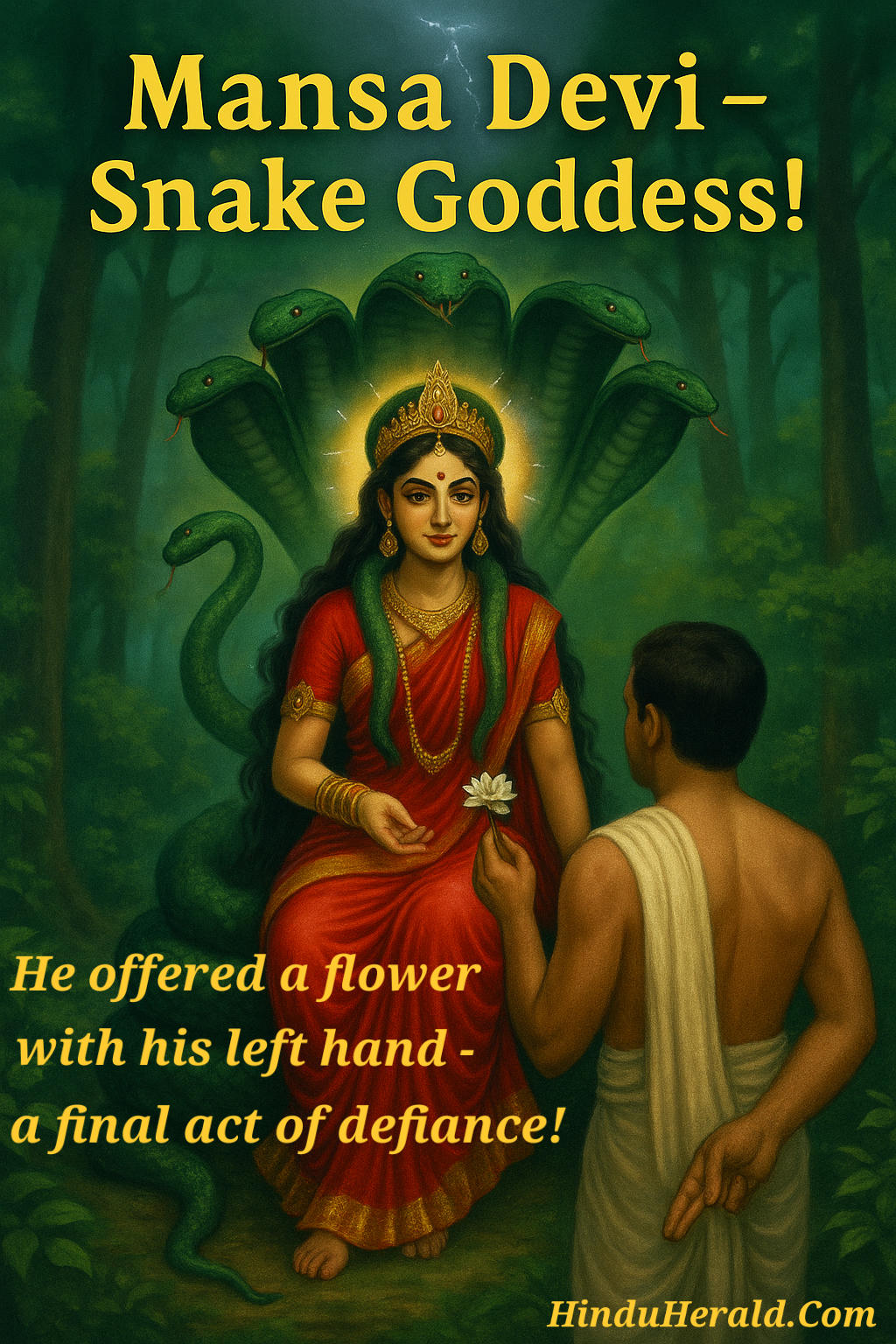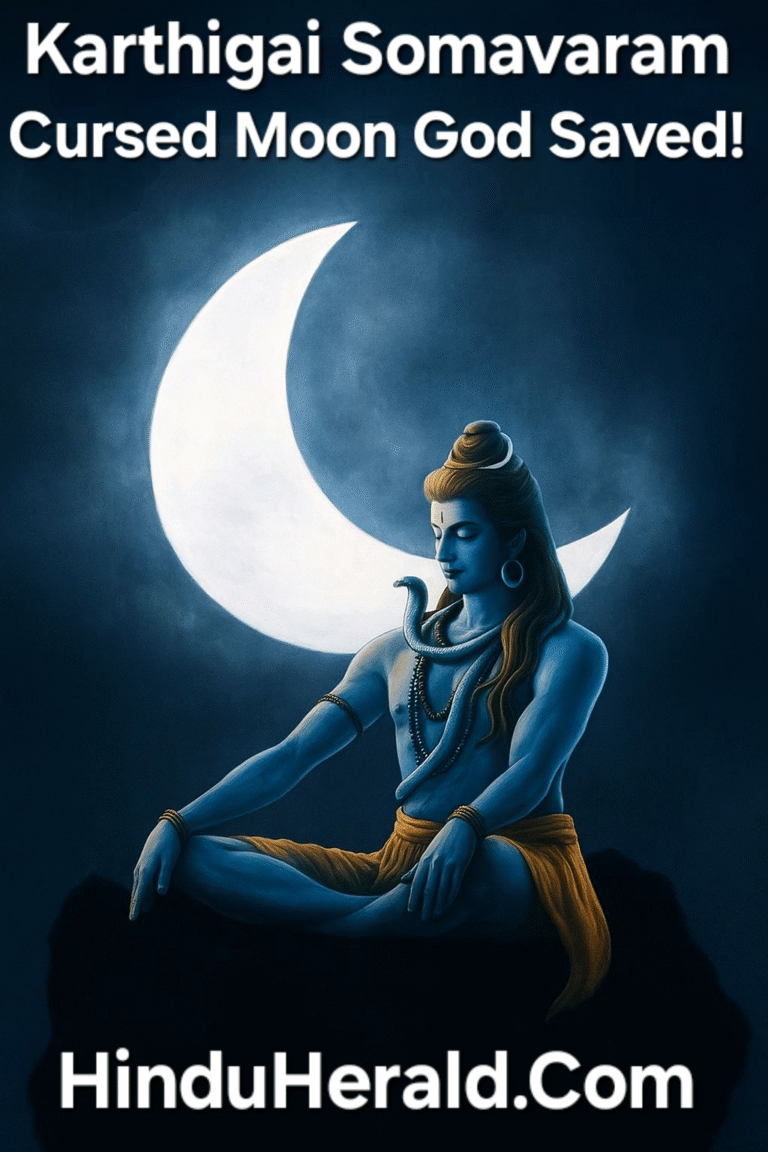
Mansa Devi: The Snake Goddess Worshipped During Shravan
In the sacred month of Shravan, many turn to Lord Shiva — the great poison-bearer who drank Halahala to save the cosmos. But there’s another divine figure whose presence looms large during this monsoon season: Mansa Devi, the snake goddess. Her stories are raw and emotional, her worship fiercely rooted in folk tradition, and her power unmistakable.
From Bengal to Haridwar, from the tragic tale of Behula to the rituals of Manasa Puja, her presence continues to ripple through the hearts of devotees.
Keep reading to discover Mansa Devi’s origins, her divine family, her iconic stories, how she is worshipped in different states, and how her influence still protects millions from danger.
Divine Lineage & Sacred Roots
Mansa Devi is said to be the daughter of the great sage Kashyapa and his wife Kadru, the mother of serpents. Thus, she is a direct descendant of the Nāga lineage. Her brother is Vasuki, the serpent king who coils around Shiva’s neck. Some accounts say she emerged from Shiva’s mind, making her both serpent-born and Shiva-connected. This double origin gives her a unique place in Hindu devotion — both celestial and earthly.
Some scholars also believe that Mansa originated as a tribal or forest goddess, who was later assimilated into mainstream Hinduism. This may explain why her worship is still deeply connected to nature, snake holes, and village altars rather than grand temples.
She is known by many names across India: Manasa, Padmavati, Vishahari (remover of poison), Bishohari, and Nagmata (Mother of Serpents).
The Story of Chand Sadagar: Pride, Grief and Reluctant Worship
One of the most gripping legends about Mansa Devi comes from the Manasa Mangal Kavya, a Bengali folk epic written between the 13th and 18th centuries by poets like Bipradas Pipilai, Ketakadas Kshemananda, and others. It is in this narrative that Mansa’s power, persistence, and pain are most vividly portrayed.
Perhaps the most striking tale about her is that of Chand Sadagar, a wealthy and devout merchant who refused to worship Mansa Devi, calling her a “goddess of low birth.” What followed is one of the most haunting theological dramas in Hindu folk religion.
The Deaths of Chand’s Six Sons
1. First son, Shankchud – Bitten by a snake shortly after birth. Chand still refused to worship Mansa Devi.
“The people whispered, but Chand stood firm.”
2. Second son, Padmachud – Died of a venomous bite while playing. Chand blamed fate, not the goddess.
“He refused again to bow.”
3. Third son, Chandraketu – Killed on his wedding night. The bride was left widowed, and whispers grew.
“Chand still would not fold his hands.”
4. Fourth son, Sudarshan – Perished in a temple while offering a prayer to another deity. Some say the idol cracked.
“Even the gods trembled, but Chand’s pride held fast.”
5. Fifth son, Hemchud – Died aboard a merchant ship, surrounded by panicked sailors. The sea was calm — it was no storm.
“The venom had followed him across the waters.”
6. Sixth son, Kamalkant – Poisoned in his sleep. His mother wailed. The town begged Chand to relent.
“Still he would not speak Mansa’s name.”
Only Lakhindar, the seventh son, remained — and he too would die, bitten on his wedding night by a snake Mansa sent into the bridal chamber. His bride, Behula, carried his corpse on a raft and, through prayer and penance, moved the gods themselves. Her devotion led to Lakhindar’s revival — but only on one condition: Chand Sadagar must finally offer worship to Mansa Devi.
The Reluctant Worshipper
And so, defeated but still proud Chand Sadagar offered a flower to Mansa — but with his left hand. In Hindu culture, this is a mark of deep insult. But it was enough. Mansa accepted.
This single act — a reluctant gesture of surrender — captures the goddess’s nature. She doesn’t need your love. But she will have your respect
Manasa Puja: Rituals Rooted in Earth and Emotion
The festival known as Manasa Puja is primarily observed during the Shravan month (mid-July to mid-August), especially on Nag Panchami. It is most prominent in West Bengal, Assam, and rural Odisha and Bihar.
Worship traditions include:
- Clay idols or ghats (pots with mango leaves and water)
- Offerings of milk, turmeric, vermilion, and flowers
- Women observing vratas (vows) and fasting for their family’s health
- Pouring milk into snake holes or at sacred trees
- Reciting or singing from the Manasa Mangal Kavya
The worship is deeply non-Brahminical, often led by women and passed down through oral traditions.
Regional Worship Styles
West Bengal
- Focus on Manasa Puja throughout Shravan
- Home altars, under trees, or in temporary pandals
- Strong oral tradition of storytelling and songs
Assam
- Strong links to tribal origins
- Snake idols, earthen pots, and sacred trees are used
Bihar & Jharkhand
- Offerings at anthills and snake mounds
- Village-led worship, especially by women
Odisha
- Blended with local goddesses like Shitala or Mangala
- Manasa is seen as a goddess of healing and fertility
Uttarakhand (Haridwar)
- Mansa Devi Temple on Bilwa Parvat
- Major festival crowds during Navratri and Shravan
- Thread-tying ritual: Devotees tie threads to sacred trees for wish fulfillment
Mansa Devi and the Legend of Nag Panchami
Another vital story linked to Mansa Devi is that of her son Astika.
When the serpent Takshaka killed King Parikshit by entering a fruit and biting him, the king’s son Janamejaya vowed revenge. He began the Sarpa Satra, a fire ritual to destroy all snakes.
One by one, serpents fell into the flames — until Astika, Mansa’s son, intervened and convinced Janamejaya to stop. His wisdom ended the genocide and saved the serpent race.
This act is commemorated as Nag Panchami, when snakes are worshipped, not feared.
Did You Know?
- Manasa Puja is rarely performed by temple priests — it survives through women-led rituals.
- She is called Vishahari — \”the one who removes poison.\”
- She is sometimes accompanied by a figure named Neta.
- Her worship thrives in sacred groves, not stone temples.
Final Thoughts
In a world of grand temples and polished mantras, Mansa Devi remains raw and rooted — a goddess of poison and protection, of defiance and healing. Her legends are not just tales; they are spiritual memories carved into the collective soul of India’s folk heartland.
From the defiant flower offered with the left hand, to the song of Behula drifting downriver — Mansa Devi’s worship reminds us that even pain can be holy.



